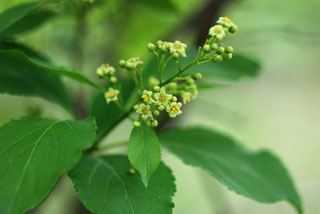BITTERSWEET
|
 |
| File Size: 45 KB |
|
|
|
Celastrus scandens L.
|
| Geary County, Kansas |
| Height: Vine, to 60 feet |
| Family: Celastraceae - Staff Tree Family |
| Flowering Period: May, June, July |
|
| Also Called: | | American bittersweet, climbing bitterswet. | | Trunks: | | Stems clambering or climbing; bark light gray, smooth or exfoliating in thin flakes or sheets; wood white, soft. | | Twigs: | | Brown to grayish brown, flexible, glabrous; leaf scars half-round; buds reddish brown, ovoid, apex obtuse, scales glabrous. | | Leaves: | | Deciduous, alternate, simple; petiole .4 to 1.2 inch; blade elliptic to ovate-oblong, 1.2 to 4.8 inches long, .6 to 2.8 inches wide, base tapered, margins minutely toothed, apex acuminate, surfaces abaxially light green, glabrous, adaxially green, glabrous. | | Flowers: | | Terminal on new growth, panicles, 6-40-flowered; peduncles .8 to 2.8 inches, glabrous; pedicels .08 to .16 inch, glabrous, jointed. Flowers unisexual and bisexual, radially symmetric; sepals 5, distinct, ovate, .04 to .08 inch; petals 5, distinct, white to greenish white, triangular to ovate, .12 to .16 inch; disk 5-lobed; bisexual: stamens 5, to .7 inch, arising from ends of lobes; pistil 1; style 1; stigma 3-lobed; staminate: stamens 5; pistillode present; pistillate: staminodes 5; pistil 1; style 1; stigma 3-lobed. | | Fruit: | | August to October; capsules, globose, 3-valved, .3 to .5 inch diameter, smooth to wrinkled, valves orange; seeds reddish brown to brown, ovoid, ca. .24 inch, ridged adaxially; aril red, completely surrounding seed. | | Habitat: | | Woods, thickets, fencerows, roadsides, rocky hillsides, stream banks, bases of bluffs, margins of upland prairie; rocky soils. | | Distribution: | | Principally in east 4/5 of Kansas | | Origin: | | Native | | Toxicity: | | The fruit can cause mild digestive disturbance but are eaten by birds. The leaves are toxic to horses. | | Uses: | | Native Americans cooked the inner bark as an emergency food source in the winter, chewed the roots for coughs, took an infusion of bark to settle the stomach, and steeped the roots and applied the liquid on sores and the teeth and gums of teething infants. The Lakota rubbed chewed roots on the body, believing it would make them resistant to wounds. Birds nest in the twisting vines. | | Comments: | | Bittersweet is the only species of Celastrus native to North America. It is sometimes planted as an ornamental. The fruits persist into winter. |
|
| Bittersweet staminate flowers |  | | 57 KB | | Geary County, Kansas |
| | Bittersweet staminate inflorescence |  | | 53 KB | | Geary County, Kansas |
| | Bittersweet leaf |  | | 45 KB | | Geary County, Kansas |
| | Bittersweet |  | | 147 KB | |
| | Bittersweet fruit |  | | 70 KB | | Marshall County, Kansas |
| | Bittersweet fruit |  | | 86 KB | | Marshall County, Kansas |
| | Bittersweet immature fruit |  | | 70 KB | | Tallgrass Prairie National Preserve, Chase County, Kansas |
| | Bittersweet bud |  | | 36 KB | | Morris County, Kansas |
| | Bittersweet bud |  | | 24 KB | | Morris County, Kansas |
| | bittersweet fruit |  | | 65 KB | | Riley County, Kansas |
| | Bittersweet staminate flowers |  | | 49 KB | | Riley County, Kansas |
| | Bittersweet flowers |  | | 35 KB | | Marion County, Kansas |
| | | |
|
|
|